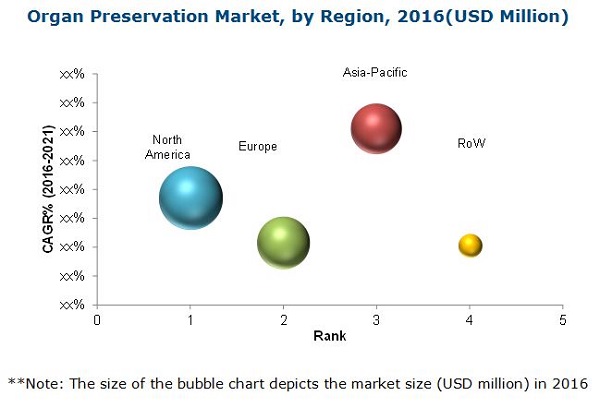“The Organ Preservation Market is poised to reach USD 241.2 Million by 2021, growing at a CAGR of 7.8%, during the forecast period of 2016 to 2021.”
The demand for organ preservation solutions and transport devices has been on the rise due to the growing organ transplants across the globe and better transplant outcomes for end-stage diseases. The technological advancements in the organ preservation technique have enabled better transplant outcomes and spurred the demand for preservation solutions and transport devices for transplantation.
Major Growth Drivers:
# Rising Cases of Multiple Organ Failure in Aging Population
# Technological Advancements
# Increasing Government and Ngo Initiatives to Encourage Organ Donation
# Rising Number of Solid-Organ Transplantation Procedures
Growth Restraints:
# High Cost of Organ Transplantation

Opportunities:
# Normothermic Machine Perfusion: A New Paradigm for Organ Preservation
Challenges:
# Significant Gap Between Number of Organs Donated and Organs Required Annually
# Limited Medical Reimbursements for Organ Donation and Transplantation
Get the Sample Pages@
https://www.marketsandmarkets.com/requestsampleNew.asp?id=261269915
The organ preservation market is segmented on the basis of preservation solution, technique, organ type and region. By preservation solution, the transplantable organ preservation & transport market comprises of University of Wisconsin (UW) solution, Custodiol HTK, Perfadex and Others (Euro-Collins & Celsior). In 2016, the University of Wisconsin solution segment is estimated to account for the largest share of the transplantable organ preservation & transport market and is expected to grow at the highest rate during the forecast period. This large share can be attributed to its prolific usage in the storage of kidney, liver, and pancreas, better transplantation outcomes, less histological damage, and improved physiological function of organs.
By technique, organ preservation market comprises static cold storage, hypothermic machine perfusion and normothermic machine perfusion. In 2016, the static cold storage segment is estimated to account for the largest share of the transplantable organ preservation & transport market and hypothermic machine perfusion is expected to grow at the highest rate during the forecast period. The growth of this segment can be attributed to factors such as better long-term graft survival rates, decreased vasospasm, and ability to provide metabolic support.
On the basis of organ type, the transplantable organ preservation & transport market is divided into kidneys, liver, lung, heart and others (Pancreas & Intestine). In 2016, the Kidneys segment is expected to account for the largest share of the market and grow at the highest rate. The growth of this segment can be attributed to factors such as rising cases of kidney failure, improvements in graft survival, and long-term graft function
On the basis of region, the market is divided into North America, Europe, Asia-Pacific, and the Rest of the World (RoW). In 2016, North America is expected to account for the largest share of the organ preservation market. Its large share can be attributed to growing cases of kidney failure, rising organ transplants, favorable reimbursements scenario within some provinces in Canada, and novel technological advancements by U.S. players. However, the Asia-Pacific market is slated to grow at the highest CAGR during the forecast period due to the new regulatory framework in China, and increasing organ donations in Asia-Pacific and serve as a revenue pocket for companies offering organ preservation solutions and transport systems
The major players in organ preservation market includeOrgan Recovery Systems (U.S.), Xvivo Perfusion AB (Sweden), Essential Pharmaceuticals LLC (U.S.), Dr. Franz Kohler Chemie GmbH (Germany), and Waters Medical Systems LLC (U.S.), among others.
You Can Also Talk to Our Research Experts for More Detailed Information
Target Audience
- Preservation Solutions and Devices Providers
- Life Sciences Companies
- Medical Device Manufacturers
- Market Research and Consulting Firms
- Healthcare Service Providers
- Medical Research Institutes
- Regulatory Bodies
- Venture Capitalists